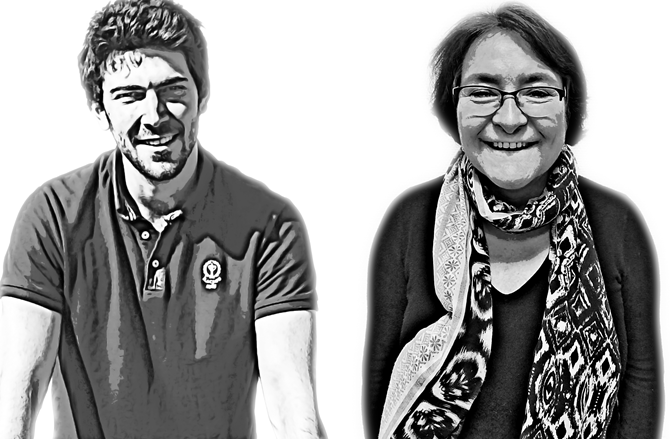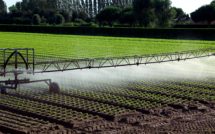

This is part of our special feature on Food, Food Systems, and Agriculture.
Baptiste Grard In the five years that we have known each other, I have been increasingly amazed at the dynamic trends that can be observed around urban agriculture, which could be defined as “an industry located within (intra-urban) or on the fringe (peri-urban) of a town, city or metropolis, which grows or raises, processes and distributes a diversity of food and non-food products, (re-)using largely human and material resources, products and services found in and around that urban area, and in turn supplying human and material resources, products and services largely to that urban area” (Mougeot 2000). When we met in 2013 after my master in ecology, I was starting an internship in the research project T4P (Parisian Productive rooftoP, Pilot Project, which I will come back to). At the time, you had just created the Urban Agriculture team called “Agricultures Urbaines” with other colleagues. As a starter to our conversation, could you perhaps tell us how this team came about?
Christine Aubry Indeed, when you came onboard, our research team had only existed for a year! It was the result of over ten years of research on peri-urban agriculture and its link to the city through short supply chain (“circuits courts”). In parallel, our research started to focus on community gardening that had been exploding in terms of the numbers of gardens since the beginning of 2000. Then, around 2012-2013, I started feeling the urgency of bringing attention to intra-urban agriculture in France beyond the scope of gardens. There was a growing interest that was tangible in municipalities (starting with Paris – see the call for project named “végétalisation innovante” in 2013) and was carried out by innovative stakeholders such as UpCycle, which later became the firm La boîte à Champignons. At that time, we came into contact with Canadian researchers and colleagues. In Canada, this movement had already been at the heart of urban environment for a couple of years.
Baptiste Grard Indeed, it’s interesting to observe the different dynamics and forms of urban agriculture today across Europe, North America, and Asia.
Christine Aubry You are right. The main difference in France is the lower development of high-tech forms of urban agriculture, such as hydroponic urban greenhouses and/or indoor farming under a controlled environment. Our urban structures being less dense than in North America and Asia, surrounded by productive agriculture areas, and the fact that our climate is overall favorable, are all part of the explanation for this difference. As an example, in Singapore, if you want fresh lettuce, because of the lack of cropping land, you’d better get it from the city. This reality has allowed for and shaped the development of many urban farming projects in this megacity. While in the Parisian region we produce more lettuce that we consume (see the agricutural statistics)!
Baptiste Grard To sum up the different existing forms of urban agriculture in France today, we can distinguish five major types, for which CEREMA has provided one example of classification. First, the “classical”peri-urban form in short supply chain…
Christine Aubry A model that is experiencing a great evolution! Partly due to “miniaturization,” with growing attention paid to micro-farms (Morel 2016; Chang and Morel 2018) and the premise of change seen in the bigger peri-urban exploitations that are starting to develop production workshops for cities.
Baptiste Grard Secondly, we have different types of “associative gardens,” which can be shared plots – with only one collective plot- or family – one family per plot. Those had existed in France for over a century in the form of family gardens.
Christine Aubry In great evolution as well! The cropping plots have had a tendency to shrink in order to adapt to urban density and have moved from building floors to roofs, which was the starting point for our research project T4P.
Baptiste Grard Third, we have multifunctional urban micro-farms (Daniel 2017), a concept that emerged recently and accounts for intra-urban farms located on small plots with a moderate activity of selling alimentary produce. They base their economic model mainly on pluri-activity and territorial anchoring through, for example, exchanges of flows such as waste, compost, water, or even employment.
Christine Aubry These forms are currently undergoing a great development as well because, along with gardens, they fulfill key roles in areas experiencing urban renewal, in particular because they contribute to social cohesion. For a limited time, we have seen the emergence of micro-farms mainly dedicated to food production using artificial/technological systems such as hydroponic or aeroponic (see the example of Agripolis). This brings us to the fourth type of urban agriculture: the urban greenhouse (Sanyé-Mengual et al. 2013). We have a few examples in France in the city of Romainville (in the department of Seine Saint-Denis), which has a farming tower project (see here). However, this type of urban greenhouse can face problems of acceptance by people in the neighborhoods where they are implanted and/or difficulties in production cost, which can make their produce uncompetitive. This may lead these projects to transform, as was the case in Romainville, where the initial idea was entirely designed for food production, but today, it has instead become a multifunctional project with educational and social activities developed in the neighborhood.
Baptiste Grard To complete our overview of urban agriculture, we can also mention indoor farming, which is split into two categories since it can be either low tech or high tech. An example of such farms is “La Boîte à Champignons,” which aims to grow mushrooms using coffee grounds in containers or basements. You can also find shade vegetables such as endives (for instance the project cycloponics) or farms where production takes place in a totally controlled environment, for example, strawberries in containers at Agricool.
Christine Aubry In the case of indoor farming, it is also interesting to note that in France, some urban farmers gear their production to the cosmetic market, or even pharmacology, rather than towards local food distribution.
Baptiste Grard All in all, what we can say is that one of the determining factors in the different forms taken by farming in the urban environment are constraints, specifically spatial constraints. The history and evolution of urban agriculture is really the story of adaption to the scarcity of useable and affordable space.
Christine Aubry That is true. And it was the starting point for the research project T4P, which is one of the projects structuring our research team. In 2011-2012, we observed in Paris a rising demand for associative gardens, which suffered from the lack of space at ground level. From this observation, came our idea of climbing onto rooftops to install gardens! You are now managing this project and have supervised its activities a few times!
Baptiste Grard Indeed, I have had the opportunity of overseeing this project since 2013. The project has developed over the years, starting with a first explorative phase aiming at testing different types of soil solely based on waste from the city, then to a more scientific phase, in particular through my doctoral dissertation. My PhD had two goals: First, the study of “constructed soils” (made only of urban waste) and secondly their environmental functions.
Christine Aubry Perhaps we need to explain why we chose to use only urban waste as soil. First, we wanted to be in a circular economy at the scale of the city in order to valorize products that are nowadays considered as waste and either burned or buried. And secondly, we wanted to avoid the use of natural soil. We indeed would be well-advised to do so because of the energy cost of transporting soil to the city, as well as the ethical cost since that would mean removing soil from agricultural areas to transport it to the city! Finally, we wanted to limit the load on the roof as organic waste/product is much lighter than natural earth.
Baptiste Grard Thanks for this complementary explanation. Indeed, the use of the city’s byproducts is the major constraint that we have had in our experiment. Looking at results, the first phase has allowed us to prove that important levels of food production could be achieved with this type of constructed soil. This high level of production is also associated with a low level of food contamination regarding trace metal element (Grard et al. 2015). Contamination was and still is an important concern for urban agriculture projects. After completing this first phase, we have strengthened our results regarding levels of food production and contamination thanks to the diversification of cultivated plants in terms of association and rotation. For instance, we may grow lettuce at the same time as we grow tomatoes and basil, in effect moving from a situation of monoculture to five or six different cultivars a year. Our work has also shown the multi-functionality of this type of roofs with regard to their environmental function (Grard et al. 2018). In fact, not only are they able to produce food, but they also retain water -preventing it from running off into the urban environment-, store carbon, valorize waste and potentially support biodiversity. (Joimel et al. 2018). Beyond these results, my dissertation, as well as other research projects (such as the research project SITERRE) have shown that soils (constructed or not) play a key role in influencing directly and indirectly the nature and the intensity of delivered ecosystem services, which represent the benefits that humans can draw from the environment. It was also shown that the composition of a constructed soil is a balance between plant needs (that we want to satisfy) and ecosystem services (that we expect from this kind of green infrastructure). As an illustration, when I studied Technosols (i.e.: constructed soil) in my dissertation, it was shown that high levels of production could be linked to a leaching of certain elements into the water as they are not retained by Technosols. This observation revealed a potential degradation in water quality resulting from this type of green roof. This should be a point of focus for future research: Yes, we can create Technosols by using only urban waste, but we need to further work on an equilibrium in Technosols composition regarding the different functions expected. So, now that I have given the details of the main results of the experimentation (that you can find on a dedicated website), could you tell us about future research topics on the roof?
Christine Aubry With pleasure. At the end of the year, we will start a new experimentation phase in the research project. We cross our fingers to be able to fund it! Nevertheless, we have no lack of enthusiasm or ideas. We want to develop three research axes: The first one will be around the thermal impact of green roofs (whether productive of biomass or not). Initial measurements have already been made but we need to investigate further as there is a lack of direct measurements in this domain. Secondly, we want to test new urban organic waste.
Baptiste Grard “New”?
Christine Aubry New, not because we just discovered them, but because new legislation in France puts collectivities, firms, and individuals under an obligation to valorize part of their bio-waste. This novel legislation has the advantage of supporting new initiatives and activity sectors in waste valorization to find a solution to two major challenges. The first one is to conceive efficient waste collection and treatment systems in the urban environment, as well as an efficient system of waste valorization in urban and peri-urban environments. Among those wastes, we can mention an originality: urine. It is already part of an experimental trial as a fertilizer for cereal cropping system. So, why not use it soon in cities for urban agriculture? Our third and last research focus will be to take advantage of the city’s disadvantages: urban heat, known as the “urban heat island effect.” This supplementary heat could allow us to enlarge the possible variety of vegetables that we are able to grow: gombo (okra), brède (type of leafy green), petsaï (napa cabbage).
Baptiste Grard A nice program that I hope we will bring to realization! In any case, I think that the research project T4P is a good illustration of a part of our work on services delivered by urban agriculture. Beyond the roof, we just started collaborating with another laboratory on the research project SEMOIRS (funded by ADEME) that aims at studying ecosystem services delivered by urban micro-farming at ground and roof level. Moreover, apart from the environmental services that are essential to make our future cities more livable and sustainable, there are other research topics led by the team: Tell us more about those.
Christine Aubry The first research focus is to lead a multi-criteria evaluation on the sustainability of micro-farms through two PhDs that are about to start. One will be on life cycle assessment and the other on criteria of economic, social, and environmental sustainability. The second part will be to extend the knowledge that we already have about the technical and economical operation of urban micro-farms, based on agroecology (following the work of Kevin Morel and Anne-Cécile Daniel). Finally, we will work to better comprehend the role of urban agriculture (intra or peri-urban) in food systems in various territories. The latter part tries to give an answer to the doubts many municipalities hold when they want to develop a food policy aiming at supplying more local food from local producers within that territory.
Baptiste Grard Through this conversation, we can see that urban agriculture is an open door to delve into many issues around the functioning and development of urban environment: food provisioning, habitat fragmentation, soil waterproofing, waste recycling, well-being, social linkages, etc. This explains, in part, why there is a strong and undeniable dynamic behind urban agriculture today, as evidenced by the creation of the French national association for professional urban farming, AFAUP in December 2016. Nevertheless, if we want these projects to last into the future and fulfill the function that we expect from them, we need to keep in mind key points. First, what are the conditions of development for urban agriculture projects in a specific contexts, taking into account the territorial constraint: neighborhood, other structure or producer nearby, opportunities for linkages with other structures or re-use of material.)? Secondly, in designing projects, we need to ask what the expected functions really are. Is it only food production or also social and/or environmental functions, because the choice of technical systems and the skills of the future farmer are strongly dependent on this hierarchy. Third, what are the conditions of installation and perpetuation (property, land access and security)? And finally, what environmental cost/benefit equilibrium does each project need to be taking into consideration. All these points are dependent on the local urban structure as well as the local climatic and social conditions.
Christine Aubry So, our research team, as well as many other researchers, have many years of fascinating research ahead of them on this topic of urban agriculture!
Christine Aubry is a researcher at the Institut national de la recherche agronomique (INRA), AgroParisTech, Université Paris-Saclay (UMR SAD-APT). She has been researching urban agriculture for more than a decade. She started working in farm technical management, which brought her to Antananarivo (Madagascar) from 1999 to 2002. This was the starting point of her interest in urban agriculture, which led her to work on peri-urban agriculture, short supply chain and over the last decade on intra-urban agriculture.
Baptiste Grard is an ecologist at the Institut national de la recherche agronomique (INRA), AgroParisTech, Université Paris-Saclay (UMR Ecosys). He earned a PhD on rooftop farming in 2017 and is currently working as a post-doc co-coordinating the research project SEMOIRS on ecosystem services delivered by urban micro-farms. He is also involved in the research project FEW-Meter about the environmental impact of urban micro-farms.
Bibliography:
Chang M, Morel K (2018) Reconciling economic viability and socio-ecological aspirations in London urban microfarms. Agron Sustain Dev 38:9. doi: 10.1007/s13593-018-0487-5
Daniel A (2017) Fonctionnement et durabilité des micro-fermes urbaines. Une observation participative sur le cas des fermes franciliennes.
Grard BJP, Chenu C, Manouchehri N, et al. (2018) Rooftop farming on urban waste provides many ecosystem services. Agron Sustain Dev 38:. doi: 10.1007/s13593-017-0474-2
Joimel S, Grard B, Auclerc A, et al. (2018) Are Collembola “flying” onto green roofs? Ecol Eng 111:117–124. doi: 10.1016/j.ecoleng.2017.12.002
Morel K (2016) Viabilité des microfermes maraîchères biologiques. Une étude inductive combinant méthodes qualitatives et modélisation. AgroParisTech – INRA
Morel K, San M, Gilbert F (2017) Small can be beautiful for organic market gardens : an exploration of the economic viability of French microfarms using MERLIN. Agric Syst 158:39–49. doi: 10.1016/j.agsy.2017.08.008
Mougeot LJA (2000) Urban agriculture : definition, presence, potentials and risks. Grow cities, Grow food Urban Agric policy agenda 1–42
Sanyé-Mengual E, Cerón-Palma I, Oliver-Solà J, et al. (2013) Environmental analysis of the logistics of agricultural products from roof top greenhouses in Mediterranean urban areas. J Sci Food Agric 93:100–9. doi: 10.1002/jsfa.5736
Published on September 5, 2018.




